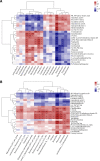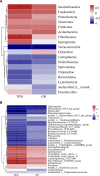Colon microbiota and metabolite potential impact on tail fat deposition of Altay sheep
- PMID: 38647275
- PMCID: PMC11237728
- DOI: 10.1128/spectrum.03103-23
Colon microbiota and metabolite potential impact on tail fat deposition of Altay sheep
Abstract
Tail fat deposition of Altay sheep not only increased the cost of feeding but also reduced the economic value of meat. Currently, because artificial tail removal and gene modification methods cannot solve this problem, it is maybe to consider reducing tail fat deposition from the path of intestinal microbiota and metabolite. We measured body weight and tail fat weight, collected the serum for hormone detection by enzyme-linked immunosorbent assay, and collected colon contents to 16S rRNA sequence and liquid chromotography with mass spectrometry detection to obtain colon microbiota and metabolite information, from 12 3-month-old and 6-month-old Altay sheep. Subsequently, we analyzed the correlation between colon microbiota and tail fat weight, hormones, and metabolites, respectively. We identified that the tail fat deposition of Altay sheep increased significantly with the increase of age and body weight, and the main microbiota that changed were Verrucomicrobia, Cyanobacteria, Akkermansia, Bacteroides, Phocaeicola, Escherichia-Shigella, and Clostridium_sensu_stricto_1. The results indicated that the diversities of metabolites in the colon contents of 3-months old and 6-months old were mainly reflected in phosphocholine (PC) and phosphatidylethanolamine (PE) in the lipid metabolism pathway. The correlations analyzed showed that Verrucomicrobia, Chlamydiae, Akkermansia, Ruminococcaceae_UCG-005, Bacteroides, and Phocaeicola were negatively correlated with tail fat deposition. Verrucomicrobia, Akkermansia, and Bacteroides were negatively correlated with growth hormone (GH). Verrucomicrobia was positively correlated with L-a-lysophosphatidylserine and PE(18:1(9Z)/0:0). Our results showed that tail fat deposition of Altay sheep was probably correlated with the abundance of Verrucomicrobia, Akkermansia, Bacteroides of colon microbiota, PC, PE of metabolites, and GH of serum.
Importance: Excessive tail fat deposition of Altay sheep caused great economic losses, and the current research results could not solve this problem well. Now, our research speculates that the tail fat deposition of Aletay sheep may be related to the abundance of Verrucomicrobia, Akkermansia, Bacteroides, metabolites phosphocholine, phosphatidylethanolamine, and growth hormone of serum. Further investigation of the interaction mechanism between these microbiota or metabolites and tail fat deposition is helpful in reducing tail fat deposition of Altay sheep and increasing the economic benefits of breeding farms.
Keywords: Altay sheep; colon; metabolite; microbiota; tail fat deposition.
Conflict of interest statement
The authors declare no conflict of interest.
Figures













Similar articles
-
The Microbiota and Cytokines Correlation between the Jejunum and Colon in Altay Sheep.Animals (Basel). 2022 Jun 17;12(12):1564. doi: 10.3390/ani12121564. Animals (Basel). 2022. PMID: 35739900 Free PMC article.
-
Alterations to the Gut Microbiota and Their Correlation With Inflammatory Factors in Chronic Kidney Disease.Front Cell Infect Microbiol. 2019 Jun 12;9:206. doi: 10.3389/fcimb.2019.00206. eCollection 2019. Front Cell Infect Microbiol. 2019. PMID: 31245306 Free PMC article.
-
Breed-specific differences of gut microbiota and metabolomic insights into fat deposition and meat quality in Chinese Songliao Black Pig and Large White × Landrace Pig Breeds.BMC Microbiol. 2025 May 28;25(1):334. doi: 10.1186/s12866-025-04051-y. BMC Microbiol. 2025. PMID: 40426050 Free PMC article.
-
Effects of L-arginine supplementation on fat deposition and meat quality in growing lambs: Interactions with gut microbiota and metabolic signalling pathways.Food Chem. 2025 Jul 1;479:143677. doi: 10.1016/j.foodchem.2025.143677. Epub 2025 Mar 6. Food Chem. 2025. PMID: 40081064
-
[Analysis of FABP4 expression pattern in rump fat deposition and metabolism of Altay sheep].Yi Chuan. 2015 Feb;37(2):174-182. doi: 10.16288/j.yczz.14-369. Yi Chuan. 2015. PMID: 25665644 Chinese.
Cited by
-
Studies on the concerted interaction of microbes in the gastrointestinal tract of ruminants on lignocellulose and its degradation mechanism.Front Microbiol. 2025 May 9;16:1554271. doi: 10.3389/fmicb.2025.1554271. eCollection 2025. Front Microbiol. 2025. PMID: 40415943 Free PMC article. Review.
-
Multi-omics reveals the mechanism of quality discrepancy between Gayal (Bos frontalis) and yellow cattle beef.BMC Genomics. 2025 Apr 7;26(1):351. doi: 10.1186/s12864-025-11519-8. BMC Genomics. 2025. PMID: 40197137 Free PMC article.
-
Gender and age-related variations in rumen fermentation and microbiota of Qinchuan cattle.Anim Biosci. 2025 May;38(5):941-954. doi: 10.5713/ab.24.0328. Epub 2024 Oct 24. Anim Biosci. 2025. PMID: 39483029 Free PMC article.
References
-
- Zhou J, Ji K, Liu H, Zhang Y, Degen AA, Jiao D, Wang W, Xie Z, Wang X, Zhou P, Yang G. 2020. Effect of air temperature on growth performance, apparent digestibilities, rumen fermentation and serum metabolites in Altay and Hu lambs. J Anim Physiol Anim Nutr (Berl) 104:1024–1033. doi: 10.1111/jpn.13318 - DOI - PubMed
MeSH terms
Substances
LinkOut - more resources
Full Text Sources

